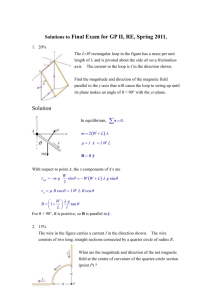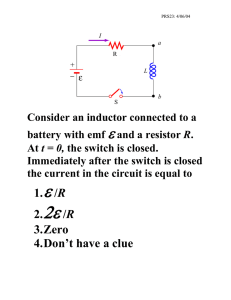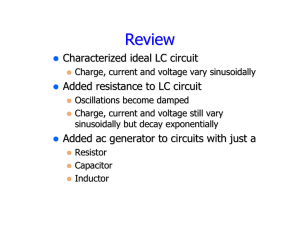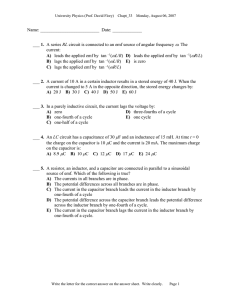Homework, Chapters 6 and 7
advertisement
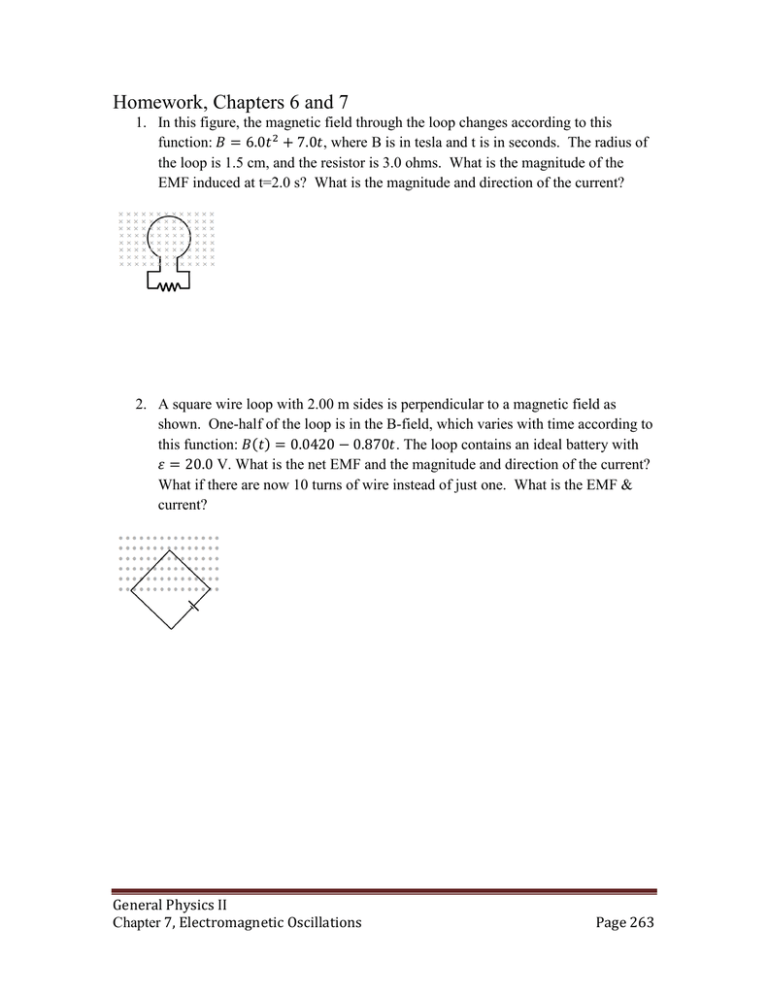
Homework, Chapters 6 and 7 1. In this figure, the magnetic field through the loop changes according to this function: = ܤ6.0 ݐଶ + 7.0ݐ, where B is in tesla and t is in seconds. The radius of the loop is 1.5 cm, and the resistor is 3.0 ohms. What is the magnitude of the EMF induced at t=2.0 s? What is the magnitude and direction of the current? 2. A square wire loop with 2.00 m sides is perpendicular to a magnetic field as shown. One-half of the loop is in the B-field, which varies with time according to this function: ܤሺݐሻ = 0.0420 − 0.870ݐ. The loop contains an ideal battery with ߝ = 20.0 V. What is the net EMF and the magnitude and direction of the current? What if there are now 10 turns of wire instead of just one. What is the EMF & current? General Physics II Chapter 7, Electromagnetic Oscillations Page 263 3. What is the magnetic flux through the loop shown in this figure? 4. Consider this circuit. a. What is the equilibrium current? b. How long does it take to reach that current? c. How long does it take to reach one-half of this equilibrium current? Write the loop rule for this circuit and show that the sum of the potentials at this time is equal to zero. When it is at this current, what is the energy stored by the inductor? General Physics II Chapter 7, Electromagnetic Oscillations Page 264 5. Consider this circuit. Initially, the capacitor is fully charged by a 12 V battery, and no current flows in the circuit. a. b. c. d. e. f. Discuss how the energy on the capacitor and inductor changes with time. When is the first instance that the current in the circuit is zero? When is the current at its maximum value? What is the angular frequency for the oscillating current? What is the charge on the capacitor at t=2s? What is the current in the circuit at t=2s? General Physics II Chapter 7, Electromagnetic Oscillations Page 265 6. Consider this circuit. The switch is in position A for a long time; then, it is flipped to position B. What are the (a) frequency and (b) current amplitude of the resulting oscillations? 7. A single loop circuit has a 7.20 Ω resistor, 12.0 H inductor, and a 3.20 µF capacitor. Initially, the capacitor has 6.20 µC, and the current is zero. Calculate the charge on the capacitor N complete cycles later for (a) N=5, (b) N=10, and (c) N=100. General Physics II Chapter 7, Electromagnetic Oscillations Page 266 8. A 50.0 Ω resistor is connect with an AC power source. The amplitude of the EMF is 30.0 V. What is the amplitude of the alternating current if the frequency of the EMF is (a) 1.00 kHz and (b) 8.00 kHz? 9. An AC power supply with EMF ε=εM=sin(ωdt), with εM=25.0 V and ωd=377 rad/s. The power supply is connected to a 12.7 H inductor. (a) What is the maximum value of the current? (b) When the current is at a maximum, what is the emf of the generator? (c) When the emf of the generator is -12.5 V and increasing in magnitude, what is the current? General Physics II Chapter 7, Electromagnetic Oscillations Page 267 10. Consider this function. Draw the phasors for points a-d. 11. Consider this transformer. The primary voltage comes to the transformer on a wire twisted with 4 turns around the iron core. The secondary voltage line has 8 turns. If the primary voltage is 100 V, what is the secondary voltage? Is this a step-up or step-down transformer? General Physics II Chapter 7, Electromagnetic Oscillations Page 268 12. An RLC circuit has a resistor of 100 Ω, an inductor of 200 mH, and a capacitor of 3 µF; it is powered by an AC generator that has a maximum EMF of 24 V at a frequency of 60 Hz. a) What is the maximum, initial current in this circuit? b) What is the phase constant? c) Write the expression for the current as a function of time. d) What is the current at t=0.1 seconds? e) Draw the phasors for VL, VR, and VC and be able to discuss which follow and which lead the EMF of the generator. f) What is the resonant frequency of this circuit? What is the current at this resonant frequency? General Physics II Chapter 7, Electromagnetic Oscillations Page 269



